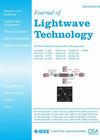双偏振调制传感干涉光纤陀螺偏振非互易和后向散射噪声抑制
IF 4.8
1区 工程技术
Q2 ENGINEERING, ELECTRICAL & ELECTRONIC
引用次数: 0
摘要
双偏振干涉型光纤陀螺仪(DP-IFOGs)是近年来发展起来的一种高性能光纤陀螺仪。然而,抑制偏振非互易和后向散射噪声是提高系统稳定性的必要条件。本文提出并演示了一种具有中间位置dp调制器的双偏振调制和传感IFOG (DPMS-IFOG)。当水平偏振光和垂直偏振光(HPL和VPL)强度平衡时,PN大小相同,但符号相反。对于BS,一部分转换为可忽略的二阶强度噪声,另一部分由于HPL和VPL之间的反向调制而增强互补性。实验中,热应变引入低频PN,偏置不稳定性(BI)从未补偿输出的0.49°/h降低到补偿输出的0.05°/h。激光驱动DPMS-IFOG的BI和ARW分别从0.94°/h降至0.06°/h和0.1667°/ h2降至0.005°/ h2,分别提高了15.66倍和33.34倍。这种创新的误差补偿机制可能在高精度ifog中找到重要的应用。本文章由计算机程序翻译,如有差异,请以英文原文为准。
Suppressing Polarization Non-Reciprocity and Backscattering Noise in Dual-Polarization Modulation and Sensing Interferometric Fiber Optic Gyroscope
Dual-polarization interferometric fiber optic gyroscopes (DP-IFOGs) have recently emerged as an attractive high-performance IFOG. However, suppression of polarization non-reciprocity (PN) and backscattering noise (BS) is necessary for improving system stability. In this article, a dual-polarization modulation and sensing IFOG (DPMS-IFOG) with a mid-positioned DP-modulator is proposed and demonstrated. When horizontally and vertically polarized light (HPL and VPL) have balanced intensities, PN manifests identical magnitude but opposite sign. For BS, a part is converted into negligible second-order intensity noise, and the other exhibits enhanced complementarity owing to the reverse modulation between HPL and VPL. Experimentally, thermal strain introduces low-frequency PN, and bias instability (BI) reduces from 0.49 °/h of the uncompensated output to 0.05 °/h of the compensated output. The laser-driven DPMS-IFOG demonstrated 15.66-fold and 33.34-fold improvements in BI and angular random walk (ARW), decreasing from 0.94 °/h to 0.06 °/h and from 0.1667°/h1/2 to 0.005°/h1/2, respectively. Such innovative error-compensation mechanisms may find important applications in high-precision IFOGs.
求助全文
通过发布文献求助,成功后即可免费获取论文全文。
去求助
来源期刊

Journal of Lightwave Technology
工程技术-工程:电子与电气
CiteScore
9.40
自引率
14.90%
发文量
936
审稿时长
3.9 months
期刊介绍:
The Journal of Lightwave Technology is comprised of original contributions, both regular papers and letters, covering work in all aspects of optical guided-wave science, technology, and engineering. Manuscripts are solicited which report original theoretical and/or experimental results which advance the technological base of guided-wave technology. Tutorial and review papers are by invitation only. Topics of interest include the following: fiber and cable technologies, active and passive guided-wave componentry (light sources, detectors, repeaters, switches, fiber sensors, etc.); integrated optics and optoelectronics; and systems, subsystems, new applications and unique field trials. System oriented manuscripts should be concerned with systems which perform a function not previously available, out-perform previously established systems, or represent enhancements in the state of the art in general.
 求助内容:
求助内容: 应助结果提醒方式:
应助结果提醒方式:


